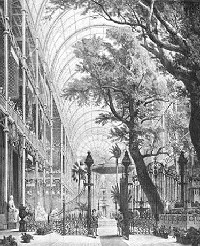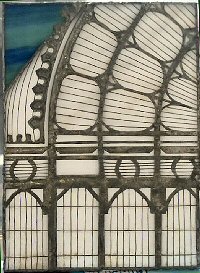Little Adventures
*
Crystal Palace
 One Saturday night in 1976, I took Pam to see a movie called The Great Train Robbery.
This told the tale of a gold shipment destined for the Crimea that was stolen from
a moving train just outside London in 1855. The movie was really well done, and for
two hours we enjoyed this story of Victorian England. As the credits rolled, I saw
that the movie was based on a novel by Michael Crichton. The next day I bought a
copy of his book, figuring that as good as the movie was, the book would probably
be even better.
One Saturday night in 1976, I took Pam to see a movie called The Great Train Robbery.
This told the tale of a gold shipment destined for the Crimea that was stolen from
a moving train just outside London in 1855. The movie was really well done, and for
two hours we enjoyed this story of Victorian England. As the credits rolled, I saw
that the movie was based on a novel by Michael Crichton. The next day I bought a
copy of his book, figuring that as good as the movie was, the book would probably
be even better.
I read and thoroughly enjoyed The Great Train Robbery. Unlike the movie I could take my time and build an image of Victorian England for my mind's eye to explore. As I read, a complicated world populated by snakesmen, screwsmen, and swell mobsmen gradually took shape in my head. Occasionally I would stop reading and have a look around the place on my own. Well into the story, a meeting takes place at the Crystal Palace, an enormous and glorious three-story glass building which once covered nineteen acres of ground in Hyde Park. I had trouble picturing a glass building large enough to contain mature oak trees, and when I read on and discovered that hawks had been kept inside the building to control the sparrow population, I decided that I wanted to know more.
The University of Delaware had an excellent library for this kind of exploration. There I found a book about the Crystal Palace that had pictures taken from the Illustrated London News. On a whim I looked in the card catalog to see if the library had any of these old newspapers, and it did! In a little used periodicals room, I discovered bound volumes of the Illustrated London News dating back to 1840. I'll always remember the thrill of that discovery, and the weeks that followed. Every evening I returned to this quiet nook and read the weekly newspapers from 150 years ago and 3000 miles away. I became interested in the war in the Crimea and its infamous charge of the light brigade. I watched the changing fashions and examined with interest the ads for patent remedies. Most of all I followed how things were progressing down in Hyde Park, where a giant building was rising to house the Great Exhibition of the Works of Industry of all Nations.
Prince Albert, husband of Queen Victoria, had for years been interested in the problem of improving the application of art to the manufacturing industries. His crowning glory was to be an immense exhibition of the art and manufactured goods of all the nations of the world. This, the first-ever world's fair, was to be housed in a suitable building in Hyde Park. There was some opposition to the idea, mostly from those who decried the destruction of ancient trees to make way for the exhibition building. Finally the News was able to publish a picture of the proposed building. It looked like a railway station surmounted by a giant iron dome, and indignant letters started pouring in. As the opening date for the exhibition drew near, Joseph Paxton, a man with great experience in building greenhouses, submitted his idea for a building constructed of iron, wood and 293,655 panes of glass. This could contain the sacred trees and could also be easily removed when the exhibition ended. The now desperate building committee accepted this new proposal, and I read of the week-by-week rise of the Crystal Palace and how it was filled with locomotives, statuary, artificial noses and the vegetable productions of Scotland. Finally on May first 1851, Queen Victoria opened the exhibition to the public and during the next five months over six million visitors came to view the 100,000 exhibits housed in the marvelous glass structure.
 The months flew by, and in 1852 the Crystal Palace was taken apart and moved to the
London suburb of Sydenham, where it was re-erected on top of a hill and continued
to draw enthusiastic crowds. As the Sydenham Crystal Palace took its place as a sight
to see in London, it gradually disappeared from the pages of the Illustrated London
News. Finally in 1860 I stopped reading the newspaper and returned to the Delaware
of 1976.
The months flew by, and in 1852 the Crystal Palace was taken apart and moved to the
London suburb of Sydenham, where it was re-erected on top of a hill and continued
to draw enthusiastic crowds. As the Sydenham Crystal Palace took its place as a sight
to see in London, it gradually disappeared from the pages of the Illustrated London
News. Finally in 1860 I stopped reading the newspaper and returned to the Delaware
of 1976.
Back home among my friends, I had a sense of having been somewhere and of having seen something extraordinary. Shortly after that I made a small stained glass window depicting a detail of the palace. Today this serves as my souvenir, and sometimes when I notice it at the back of my bookshelf, I remember my first visit to the Crystal Palace and the Great Exhibition of 1851.